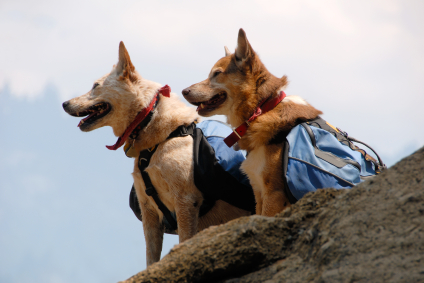 Dogs can serve multiple purposes in a SHTF scenario, but in a bug out scenario they also have a job to do – to help you get to your bug out location. To help us out, they can carry additional weight thus significantly lightening your load in the process and helping you cover more ground each day.
Dogs can serve multiple purposes in a SHTF scenario, but in a bug out scenario they also have a job to do – to help you get to your bug out location. To help us out, they can carry additional weight thus significantly lightening your load in the process and helping you cover more ground each day.
A trained dog can easily carry 25% of its own weight. Although some breeds can carry 10% to 15% more, while other breeds aren’t cut out to carry much at all. The amount you should pack also changes with age. Therefore before you begin training your dog for long distance hiking with a bag strapped to their back, discuss this topic with your vet to ensure they are healthy enough to do so.
What to Put In the Pack
As mentioned, dogs can carry a serious load, especially if they are a large breed. Keep this in mind when you are packing their gear. Similar to packing your bug out bags, consider your dogs basic survival needs: food, clothing, shelter, etc. In colder climates or if dogs are a short hair breed, they may need an additional clothing layer such as a dog vest to maintain their body temperature. Some items to place in a dog’s pack could be:
- Dog food
- Collapsible bowl for water
- Medical Kit
- Harness
- GPS devices
- Lightweight tools such as duct tape, rope
- Cooling collar
- Lightweight camping equipment
In addition, if the dog hiking packs have loops of material on this sides of the pack, carabiners can attached to carry more items. These packs are around $50 in stores, but you can easily make your own. See the sewing pattern for this project here.
How to Fit a Pack
Your first step is to measure the circumference of your dog’s chest. Most packs have a specific size so you can find the corresponding measurement. Then place the middle of the pack on your dog’s back. Straps usually fasten around the waist, chest and/or around the neck. Adjust all straps to tighten the pack to fit your dog’s body. Don’t pull too tight, as you’re not going anywhere if your dog can’t breathe. Be aware that a too-loose pack can slip off.
In a bug out situation, we all have jobs to do – even the family dog. Most dogs are happy to oblige, but check with your vet first to make sure they can carry additional weight.
This article was originally published at Ready Nutrition™ on November 26th, 2013






